Lilies - care in the fall and preparation for winter: pruning, feeding and shelter
Lilies do not require much maintenance during the summer season. It is enough to irrigate so that the soil around them is not dry, loosen the soil around each bush, remove weeds and apply fertilizers several times per season. But with the arrival of autumn, caring for lilies will be more difficult.
How to properly prepare flowers for the winter season? When do they need to be dug up, and which of them can be simply cut and covered before the onset of cold weather? All this should be reminded to those growers who decide to grow these beautiful flowers in their garden.

Content
- 1 Features of caring for lilies in the fall and preparation for winter
- 2 Pruning lilies in the fall
- 3 Autumn care for lilies after flowering, but before pruning for the winter
- 4 How to properly cover lilies for the winter
- 5 Digging up lily bulbs and storing them in winter
- 6 Mistakes in caring for lilies in autumn and in preparation for winter
Features of caring for lilies in the fall and preparation for winter
Not all types of lilies require careful care in the autumn - the simplest of them are enough to feed and cut. And you don't even need to cover before the frost starts. But varietal varieties of lilies just cannot be left for the winter. - most likely, they will simply freeze out. The main procedures carried out in the fall in a flower garden with these beautiful plants will be described below.
By the way! After flowering and in autumn, it's time for transplanting lilies to a new place, what you can read in detail about in this article... And about autumn planting — here.
Pruning lilies in the fall
When should lilies be cut in autumn and how to do it correctly? Is it really necessary to carry out this procedure: maybe just leave these plants as they are? However, experienced florists still recommend to carry out the autumn pruning of lilies... The process of pruning these flowers is simple, the main thing is to carry out this procedure on time so as not to harm the plants.
When to prune lilies: after flowering or fall for winter
Most varieties end their flowering early - by mid-summer. And many inexperienced gardeners tend to prune these flowers right away. Is it correct? It turns out not. Not only do the cut off stems look ugly in the flowerbed next to the plants that continue to bloom, but such an untimely procedure harms the lilies themselves. After the end of flowering, vital processes continue in the foliage and stems. The roots continue to grow and store nutrients for the winter, and photosynthesis continues in the foliage. Therefore immediately after the end of flowering, lilies are not cut off, and give the bulb the opportunity to gain strength (nourish) before the coming winter.
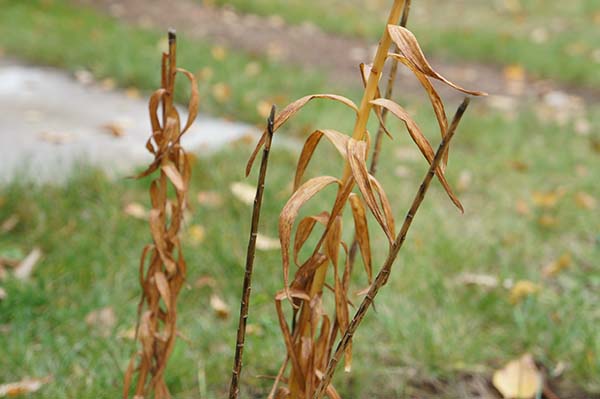
Lily pruning technology after flowering (summer) and autumn
Lilies are pruned in several stages. At the end of flowering, the petals fall off on their own, boxes with seeds begin to form in place of flowers, and they will need to be cut off so that the plant does not waste energy on the formation of seeds. In addition, most likely, this will positively affect the development and better ripening of the bulb. In general, this pruning is called summer.

Video: pruning lilies in the summer after flowering
A final trimming lilies are already in the fall, so to speak, for the winter, when the stems and leaves are withered and dry, in other words, the formation of the bulb will end. This usually happens (depending on climatic conditions) in early or mid September. Then the stems are either completely removed, or stumps up to 10-15 cm high are left.
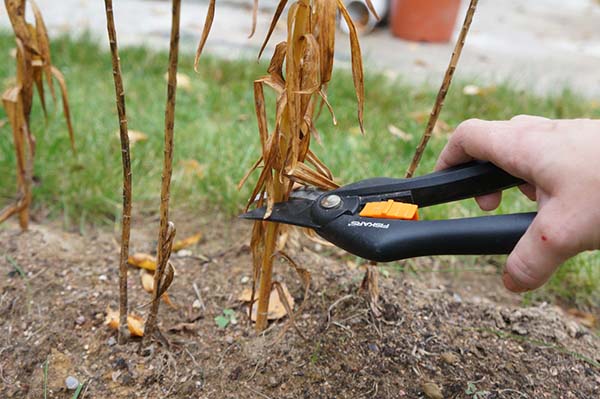
It is best not to leave withered stems and foliage uncut until spring (if the variety hibernates in the open field). They can "hide" for the winter pests or pathogens, which will wake up in the spring and bring a lot of harm to flowering plants and other crops growing in the garden and vegetable garden. It is better to collect and burn all cut off aerial parts at once.
Autumn care for lilies after flowering, but before pruning for the winter
Top dressing after flowering
Immediately after these perennials have faded, under them fertilizers should be applied, which include potassium and phosphorus. For example one can use potassium sulfate (potassium sulfate) and superphosphate, 30-40 grams per 1 sq. meter of a bed or flower bed, or a special ready-made mineral fertilizer marked “Autumn ". For lovers of organic farming, suitable bone flour (phosphorus) and wood ash (potassium), 100 grams per 1 sq. meter.

Important! However, one cannot use ash for lilies that do not tolerate alkalization of the soil, and these are varieties such as "Oriental", "Asian", "American", "LA-hybrids".
Such potassium-phosphorus fertilizing will allow the plants to ripen by the onset of winter, recuperate after abundant flowering and prepare for the onset of cold weather.These fertilizers will allow the root system to receive a large amount of nutrients and better withstand cold weather, as well as in spring will make it possible to grow faster in the aerial part of flowers.
Under those lilies that will not be dug out for the winter, a layer of rotten foliage or compost should be applied (the thickness of such a layer should be at least 8-10 cm). This fertilizer will serve as a kind of "blanket" for the roots and their additional protection from the impending frost. And in the spring, humus will be a good fertilizer and mulch for lilies.
This shelter is suitable for long-flowered, oriental and American hybrids.
The main feeding is over, but the care of flowering perennials continues.
Disease treatment
This is followed by a couple of times sprinkle the lilies with copper sulfate or Bordeaux liquid... Such treatment will protect the plants from possible diseases during the rainy season.
Watering
Already from the end of summer, that is, from about mid-August, it is recommended to exclude watering of lilies altogether, because the bulbs can simply get wet due to the abundant moisture.
How to properly cover lilies for the winter
If growers leave their flowers to winter in the open field, then before the onset of cold weather, most of them should be covered. It is possible to leave these flowers without shelter if the winters are mild in the region (for example, in the South of Russia), and the varieties are highly frost-resistant.
In principle, if lilies do not grow in the Far North (and regions close to them in climatic conditions), then many varieties and hybrids can be left in flower beds for the winter:
- Asian (tiger) hybrids;
- Martagon (curly);
- Candidum;
- Tubular;
- hybrids Longiflorum Asiatic (LA),
- OT hybrids;
- Royal;
- Daursky.
All of the above varieties feel great in the garden in winter, only they should be covered in case of severe frosts.
Shelter is necessary only long-flowered, oriental and American lily hybrids.
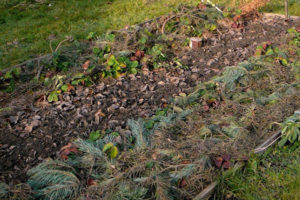
Lilies usually do not need special shelter.if a large amount of snow falls in the region in winter, which will cover the bulbs during the winter. If there is little snow or the winter will be warm, then care should be taken in advance to prepare the natural covering material. It is best to use needles (pine or spruce sawdust, or spruce branches), under which slugs and other "harmful" insects, as well as pests (especially mice), which can damage the growth points of bulbous plants, will not crawl. On top of the needles, you can pour a layer of high-moor peat, which will prevent the needles from scattering when the wind gusts. In colder regions, the top is covered with a special covering material.
By the way! In autumn, with heavy rains, it is recommended to lightly cover the lilies with a film. As soon as a constant minus is established, the film is removed.
Thus, lilies should be properly sheltered for the winter, and the shelter should be removed (removed) in time. If harvested too early, the growing stems will freeze during the spring frost. And when opened too late, the stems grow too thin.
Digging up lily bulbs and storing them in winter
But if exclusive varieties of these flowers were planted in the flower garden, the frost resistance of which the growers know little about, then it is better to dig up such lilies for the winter and store at home. There are types and varieties of these flowers that are too delicate and, even with good insulation, can freeze over the winter:
- American;
- Long-flowered;
- Oriental hybrids.
If possible, then such varieties of lilies are transplanted into a greenhouse for the winter or grown there all year round... Otherwise, the bulbs of these varieties are dug up in the fall and stored indoors.
But they dig up for the winter not only those varieties of lilies that are not highly frost-resistant. Some hybrid varieties from Asian and other species dug in the fall to separate the kidsgrown over the summer season from mother bulbs.During the winter, the babies grow so tightly to the main bulb that it will no longer be possible to separate them. In the spring, they will take on the bulk of the nutrients and moisture, which will negatively affect the development of the mother bulb and the entire plant as a whole. As a result, the plant will be weakened, will grow more slowly, and the flowering will be weak.
Therefore, in the fall, such lilies are also dug up, the bulbs are separated from the children, and then the main bulbs are planted again in the open ground. It is better to plant children in a flower garden in the spring, and leave them indoors for the winter.
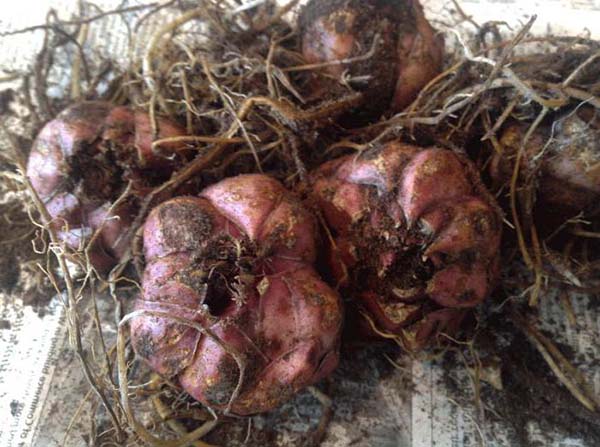
The process of digging out lily bulbs is done in stages:
- the stems of the bulbs are cut first;
- then you need to dig out the bulbs from the pre-moistened soil;
- all the soil from them must be gently shaken off;
- you should carefully examine the bulbs - whether the roots are rotten, whether there are dried scales;
- then they are washed under running cold water;
- clean bulbs are placed for half an hour in a disinfectant solution (in potassium permanganate or "Karbofos", "Maxim");
- then the bulbs are laid out to dry.
And only after carrying out all the above procedures, the lily bulbs are ready for storage.
How and where to store
It is optimal to store lily bulbs in cool and sufficiently humid rooms at positive temperatures up to +10 degrees (ideally 6-8), humidity - from 70% and above.
As for the storage method, it is good to sprinkle the bulbs with a mixture of peat and sawdust (conifers) in a box that was previously covered with newspapers, and then again close the top with newspapers or paper.
Advice! During storage, periodically inspect the lily bulbs for decay and treat them with fungicides or the most ordinary brilliant green in time.
Video: preparing oriental lilies for winter - digging and storing
Mistakes in caring for lilies in autumn and in preparation for winter
The main mistakes that beginner growers make when caring for lilies in the fall:
- continue to water, although in the fall there is already a lot of rainfall;
- forget to make top dressing in the fall;
- cut off the stems and foliage of plants too early or not cut off at all;
- do not dig out bulbs of those varieties in the fall in which children can grow to mothers over the winter;
- do not dig out those varieties that cannot winter in the open field in the fall;
- plants are not properly covered for the winter;
- too soon or too late they take shelter off the lilies.
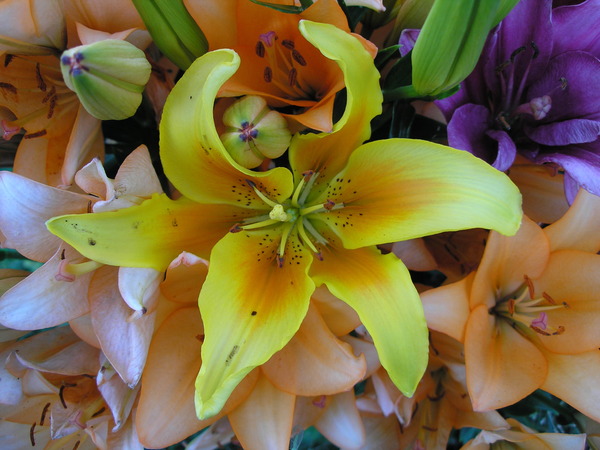
Autumn care for lilies and preparation for winter should be carried out correctly so that the plant will “thank” the owners with active flowering next year.
Video: how to prepare lilies for winter

